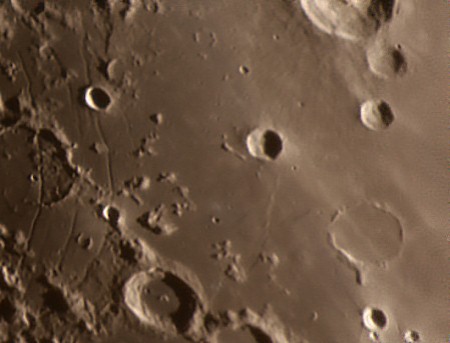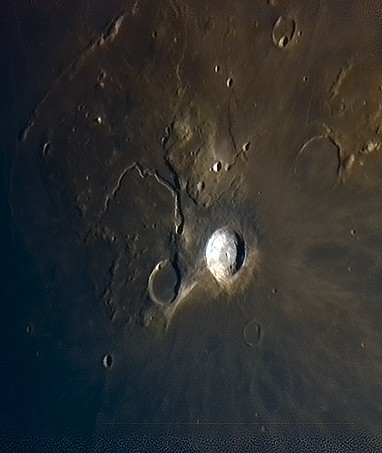At south of Frigoris Maria, not far from the crater Cassini and at east of the large walled plain Plato, is one of the most spectacular lunar valleys: Alpine Valley, which traces a cut length of 130 km through the lunar Alps.
Archive for Moon
Vallis Alpes on the Moon
Posted in Astrophotography with tags Cassini, Frigoris, Maria, Moon, Plato, Vallis Alpes on 2012/10/02 by computerphysicslabMoon scratched by the claw of a bear
Posted in Astrophotography with tags Astronomy, Astrophotography, Bullialdus crater, Canon EOS 450D, Manual-Crazy-Tracking, Meade Lightbridge 16", Moon, Newtonian, no tracking, Reflex, Registax, Rimae Hippalus, Telescope on 2011/08/31 by computerphysicslabNear Bullialdus crater (at top-right side of the picture) there is a quite interesting region called Rimae Hippalus. Hippalus crater is the big one (left-center side of the picture). It is a big crater. In this image, shadows in this crater due to a low altitude sunlight creates a visual effect, as if a great creature had stamped his bare footprint in lunar soil. Do you see it?
Aristarchus crater (Moon) with Meade Lightbridge 16 inch
Posted in Astrophotography with tags Astronomy, Astrophotography, Canon EOS 450D, crater, Manual-Crazy-Tracking, Meade Lightbridge 16", Moon, Newtonian on 2011/04/17 by computerphysicslabAristarchus crater (Moon) with Meade Lightbridge 16 inch:
Aristarchus is a large impact crater on the Moon, is in the northwest of the nearside of the Moon. It is considered the brightest of the large formations on the lunar surface, its albedo is nearly double that of most other geographical spots. The crater is bright enough to be visible to the naked eye and is stunning when viewed through a large telescope. It is also easy to identify when most of the lunar surface is illuminated by reflection of light on Earth.
The crater is located on the southeast edge of the Aristarchus Plateau, an area that contains several high volcanic features, such as wrinkling rimes. This area is known for it have been detected in a significant number of transient lunar phenomena of nature as well as by recent emissions gas radon to be measured by the spacecraft Lunar Prospector.
Mare Crisium and Palus Somni
Posted in Astrophotography with tags Astronomy, Astrophotography, Canon EOS 450D, craterlets, craters, Impact crater, Mare Crisium, Moon, Palus Somni, Proclus, Rebel XSi, solar system, Telescope on 2011/02/28 by computerphysicslabMare Crisium is one of my favorite Moon areas. There is a lot of details inside Crisium, but it is not easy to detect, because it is very fine. High aperture telescopes are needed to spot the small impact craters inside this maria, because its typical lengths are 1 or 2 kilometers wide.
Near Mare Crisium there is another big area called Palus Somni (below), that is visible in this picture made with an amateur telescope. The big and bright crater in the middle is Proclus:
The telescope used is a Celestron Nexstar 5SE and the camera is a Canon EOS 450d (Rebel XSi) DSLR. The picture actually is a mosaic made of two panes.
Auriga and Moonlight
Posted in Astrophotography with tags Astronomy, Auriga, Canon EOS 450D, constellation, Moon, no tracking, Rebel XTi, Reflex, shift-and-add on 2009/10/10 by computerphysicslabThis is a set of 71 single shots of 10 seconds each one to the Auriga constellation on 2009-10-08. The Moon was located at its south and its brightness is visible on the edge of the image and on the background gradient. The single frames were recorded using a Canon Rebel XTi (EOS 450d) and a conventional EF 18mm lens. The Kids is a triangle of stars on the upper side of Auriga constellation.

Reaching Binocular focus
Posted in Astrophotography with tags afocal, Astronomy, Binocular, blur, Moon, no tracking, sharp on 2009/09/29 by computerphysicslabSomeone asked me for help recently using this comment:
“Hello, I have 16×50 binoculars and a 7.1 mega pixel camera with 4x zoom and I’ve done what you said and looked at the Moon and the images are no where near as close as yours. The image blurs once the picture is taken of the moon and doesn’t seem no where near as close to the moon as yours. Please help.”
I would like to share the answer just in case someone is also interested.
Answer:
16x and 4x should mean a final 64x optical zoom. That is as much as when seeing through a telescope. If you are capturing frames at 7 MegaPixels this is to say they are around 3,000×2,500 pixels in size. When creating a video you need a final image size of 1,000×700 as much, so if you crop a frame of 3,000×2,500 into a final frame of 1,000×700, it would be equivalent to apply a 3x additional zoom to the image, because (1,000×700) * 3 is more o less equal to 3,000×2,500.
Bottom line: do a crop to your 7 Mpx image and you will get an effective 182x magnification.
Respecting the blur, don’t panic. The blur may be a product of the weather conditions, or a thermal issue in your binoculars.
Try to avoid make photos of the Moon when it is located directly over the roof of a neighbour. This is a very frequent source of blurring problems.
Try also to cool down your binoculars before the observation, trying to get a thermal equilibrium with the outdoor temperature.
Be sure that your digicam is functioning with a infinite focus mode. The focus must be achieved manually using the binocular focuser.
If you have the option of taking continuous shots, use it. The majority of the images recorded may be blurred, but sometimes you may get one more clear and sharp.
Well. I hope this helps you to get sharper images.
Good luck.
Mare Tranquillitatis in color
Posted in Astrophotography with tags 150/750, afocal, Astronomy, Canon EOS 450D, Manual-Crazy-Tracking, Mare Serenitatis, Mare Tranquillitatis, Moon, Newtonian, Paint Shop Pro, Rebel XTi, Reflector, Registax, Telescope, terminator on 2009/09/11 by computerphysicslabColor contrasts in the Moon are interesting even beautiful. The following picture shows Mare Tranquillitatis area and the southern part of Mare Serenitatis in full color. It was taken 4 days after full moon. The shadows in the terminator show the orography of the landscape. Mare Tranquillitatis seems to be mainly blue. This is due to its peculiar chemical composition.
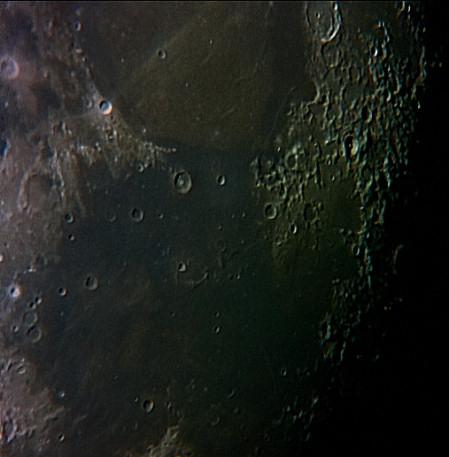
Pitiscus
Posted in Astrophotography with tags 150/750, afocal, Astronomy, Canon EOS 450D, crater, Hommel, Ideler, Manual-Crazy-Tracking, Moon, Newtonian, Noiseware, Paint Shop Pro, Pitiscus, Rebel XTi, Reflector, Reflex, Registax, Spallanzani, Telescope, terminator on 2009/09/09 by computerphysicslabPitiscus, Hommel, Ideler and Spallanzani are the only four craters of the picture with proper name. The rest of them are named by letter surnames like Ideler R or Ideler L. They are located in the South-East area of the Moon. The picture was taken on 2009-09-09 05h 20m U.T. and the terminator was passing across Pitiscus, Hommel, the two big and shadowed craters. Pitiscus is 85 km wide and Hommel is 129 km (76 miles). The smallest craters of the image are 7 km wide, that is 3.5 arcseconds, 1.75 arcseconds for the bright spot and 1.75 arcseconds for the shadow spot. Image detail could then be better for a 6-inch telescope (this is the equipment used to take the image, an scope capable up to 0.7 arcseconds of resolution). 622 subframes were recorded with the Manual-Crazy-Tracking system and stacked in Registax 5.

Posidonius
Posted in Astrophotography with tags 150/750, afocal, Astronomy, Canon EOS 450D, Chacornac, crater, Manual-Crazy-Tracking, Mare Serenitatis, Moon, Newtonian, Noiseware, Posidonius, Rebel XTi, Telescope on 2009/09/08 by computerphysicslabPosidonius is a big crater of the Moon on Mare Serenitatis. There is a lot of interesting details to observe inside: peaks, ridges, craterlets, … In the following image taken yesterday night, 4 km wide craters can be spot as small white points in the smooth surface of Mare Serenitatis.
Posidonius measures 95 km in diameter. The second biggest crater (a bit ghostly) in the picture is Chacornac, just below Posidonius. Inside it is visible a small craterlet called Chacornac A (it measures 5 km in diameter).
The third biggest crater of the picture is Daniell (31 km wide) located in the upper middle side. Its shape is not circular, but oval. This is the cause of a strange effect in perspective when comparing it with the craters nearby.
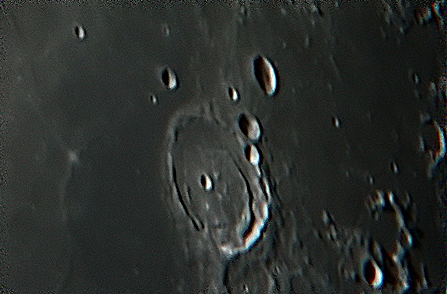
PosidoniusPosidonius is a lunar impact crater that is located on the western edge of Mare Serenitatis
Dorsum Oppel
Posted in Astrophotography with tags 150/750, afocal, Astronomy, Canon EOS 450D, Dorsum Oppel, Manual-Crazy-Tracking, Mare Crisium, Moon, Newtonian, Peirce, Proclus, Swift, Telescope, terminator, wrinkle ridge, Yerkes on 2009/09/07 by computerphysicslabDorsum Oppel is a wrinkle ridge of the Moon in Mare Crisium. 2 days after full moon is the best moment to observe it. It is a very large formation and the landscape along is quite impressive, full of small craters, tiny mountains and the smooth floor of Mare Crisium. It is important to reach a high magnification to enjoy the view (150x at least).
My setup is a 6-inch telescope, but I bet it is possible to observe it comfortably with a 4-inch refractor.

The bright and overexposed crater is Proclus. I have to work harder the dynamic range issue next time.
Swift and Peirce are the pair of craters in the upper side of the picture, near the lunar terminator. Below Peirce should be visible a 2 kms wide craterlet, but unfortunately my picture cannot yield such a resolution. According to a quick calculation, 3 kms is the smallest visible feature in theis image, and that corresponds to 1.5 arcseconds. A bit far still to the maximum theoretical resolution of a 6-inch telescope (that is around 0.7 arcseconds)
Yerkes is the big ghostly crater in the right side. Apparently there is a central peak in its center. I have been looking for a confirmation of the existence of that peak, but I haven’t found any reliable source where it is mentioned. Any hint here, I would be thankful…
Hommel crater
Posted in Astrophotography with tags 150/750, afocal, Asclepi, Casio Exilim EX-FS10, crater, digicam, Hommel, Moon, Nearch, Newtonian, no tracking, Paint Shop Pro, Photoshop, Pitiscus, point-and-shoot, shift-and-add, Telescope on 2009/08/10 by computerphysicslabHommel is a big crater with nice craterlets inside, a Clavius-style set, but smaller, measuring 76 miles (129 Km). It is located in the South-East area of the visible Moon face. This area is pledge of small craters. It is similar in appearance to the sand of a beach. Pitiscus, Nearch and Asclepi are some of its neighbors.
The picture was taken at 19 days of lunation, that is 4 days after full Moon. This is the best timing to get sharp images of the crater’s walls’ shadows. The image is an integration of 27 subframes, each one taken at 9 Megapixels single shots with point-and-shoot digicam Casio Exilim EX-FS10.

Mare Crisium & Tranquillitatis
Posted in Astrophotography with tags 150/750, afocal, Astronomy, Canon EOS 450D, Lu, Mare Crisium, Mare Tranquillitatis, Moon, Newtonian, no tracking, Paint Shop Pro, Proclus, Rebel XTi, Reflex, Registax, shift-and-add, Telescope on 2009/08/08 by computerphysicslabTwo days after full moon Mare Crisium shows a nice landscape of mountains and shadows. Some of its inner crates are visible in this picture. The small crater Swift is on the limit of visibility. The big impact called Proclus and its rays are remarkable.
To take this image I used the Canon EOS 450d, Rebel XTI DSLR camera recording video subframes and later I stacked them up with Registax 5. Some small tweaks on Paint Shop Pro 9 and ready.
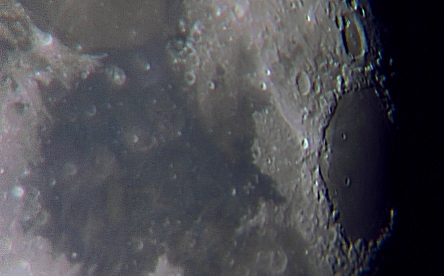
Bullialdus area
Posted in Astrophotography with tags afocal, Bullialdus, Casio Exilim EX-Z80, Meade Lightbridge 16", Moon, no tracking, Pitatus, Promontorium Taenarium, Rükl plate 53 & 54, Registax, Rupes Recta on 2009/07/18 by computerphysicslabA lot of features are located in this area of the Moon. Some of them are: Rupes Recta, Pitatus, Promontorium Taenarium, Bullialdus. It corresponds to the area covered by the Rükl plates 53 & 54.
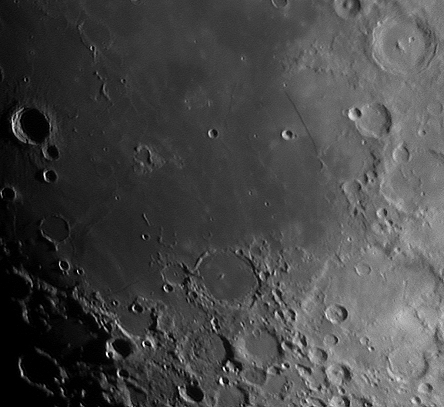
Bullialdus is the big crater at upper left side, in the shadows. Pitatus is centered in the lower side. Inside several details are visible: a peak and an inner rim. Rupus Recta is the large straight wall on the right side.
This picture was obtained after stacking (with Registax 5) 20 single frames taken with Casio Exilim pocket digital camera in afocal projection through an eyepiece using a Meade Lightbridge 16-inch dobsonian telescope.
Mare Crisium
Posted in Astrophotography with tags afocal, Casio Exilim EX-Z80, crater, Eimmart, Mare Anguis, Mare Crisium, Meade Lightbridge 16", Moon, Peirce, Picard, Registax, the serpent sea on 2009/07/03 by computerphysicslabMare Crisium is a big and round dark spot in the face of the Moon. It is easily visible through the naked eye on the right side (East) of the Moon. Inside Mare Crisium there are some interesting features, like small craters as Picard or Peirce. Proclus is the bright crater on the left (West) beyond the Crisium border. Some bright rays emerge from it crossing part of Mare Crisium. At north-east of Crisium (above right) there is a small and dark surface called Mare Anguis (the “serpent sea”). A big crater is visible at its left (West) known as crater Eimmart.
This picture was taken as the integration of 30 subframes stacked in Registax 5, from a video made with Casio Exilim EX-Z80 afocal on Meade Lightbridge 16-inches big Dobsonian, with no tracking.

Dobsonian Astrophotography
Posted in Astrophotography with tags Deep sky, Dob, Dobsonian, Moon, planets on 2009/05/14 by computerphysicslabQuestion: I have a 14 inch dob and interested in taking photos with it. Do I really need tracking?
I have a Dobsonian Meade Lightbridge 16-inch and I am also trying to do astrophotography with it. This is a challenge. The Moon is the easiest target for a Dob. Tracking is not compulsory to take good images of the Moon. Next target may be planets. Here it is my last image of Saturn through my Dob:
Next target would be bright stars and clusters. And the most difficult target of all is deep-sky astrophotography. With no tracking system you have to use some tricks to get deep sky images. I am using shift-and-add technique with moderate results.
My focuser does not let me to use my DSLR camera at prime focus, so I am using afocal method through low power eyepieces. You don’t have to spend much money to do this kind of photographic experiments. Patience and effort sometimes give more satisfaction that a lot of money expended in sophisticated equipment.
Crescent Moon focal 55mm
Posted in Astrophotography with tags Canon EOS 450D, Moon on 2009/05/07 by computerphysicslabThis is a picture of the crescent Moon taken with the DSLR camera Canon EOS 450d and their most standard lens kit: EF-S-18-55mm.
Zoom at maximum, that is 55 mm of focal length. No tracking, only static tripod to avoid blur.
I hope you like it …

4.6 days lunation Moon
Posted in Astrophotography with tags 9Mpx, afocal, Astronomy, Binocular, Casio Exilim EX-FS10, Mare Nectaris, Mare Tranquillitatis, Moon, Registax, shift-and-add, terminator, Vixen 12x80 on 2009/04/29 by computerphysicslabTonight the Moon is crescent, and high in altitude. It is a good opportunity to record our natural satellite. Terminator is almost reaching Mare Serenitatis. Mare Nectaris (actually a gulf of Mare Tranquillitatis) is now fully illuminated and its Western border walls are clearly visible.
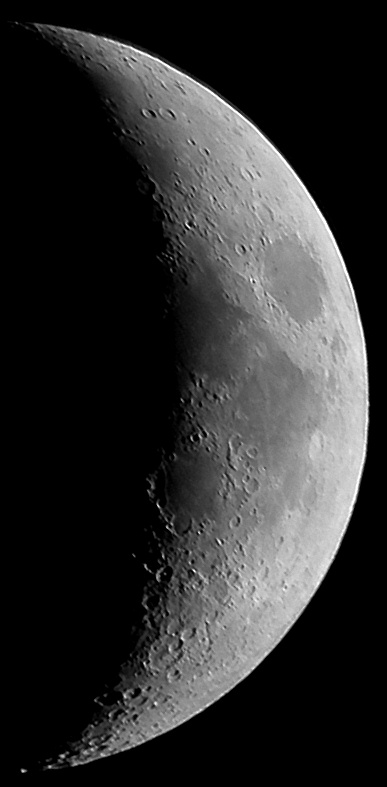
Tonight’s Moon
Posted in Astrophotography with tags 9Mpx, afocal, Binocular, Casio Exilim EX-FS10, Moon, Registax, shift-and-add, Vixen 12x80 on 2009/04/28 by computerphysicslabHere we have a 3.5 days lunation Moon. Mare Crisium is completely illuminated and some fine details may be seen, like small Swift crater (5 kms diameter). The image was a sum (Registax 5) of 10 subframes at 9Mpx using the Casio Exilim EX-FS10 and Vixen 12×80 binocular.
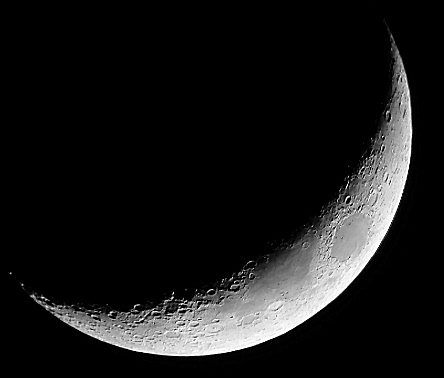
Waxing Gibbous Moon
Posted in Astrophotography with tags afocal, Binocular, Casio Exilim EX-Z80, Gibbous, Moon, Nebulosity 2, no tracking, Paint Shop Pro, phase, Registax, shift-and-add, Vixen 12x80 on 2009/04/08 by computerphysicslabYesterday’s Moon in phase waxing gibbous as seen through the Vixen 12×80 binocular, here it is. Registax 5 stacked 55 individual frames of 8 Mpx each. Nebulosity 2 was used to compensate the sideral movement and perform the de-rotation. Sharpening with Paint Shop Pro.
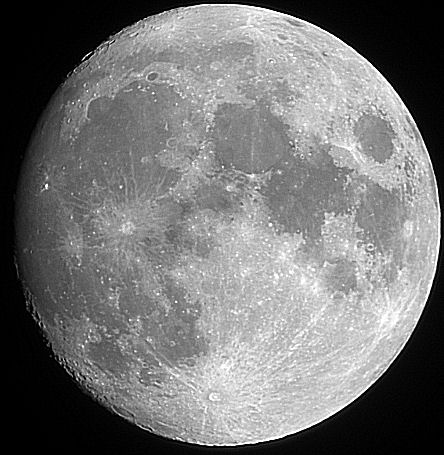
Copernicus Crater
Posted in Astrophotography with tags afocal, AutoStitch, Casio Exilim EX-Z80, lunation, Meade Lightbridge 16", Moon, no tracking, Registax, terminator on 2009/04/04 by computerphysicslabCopernicus is the name of a big Lunar crater. A video taken with the compact digital camera and the Meade Dobsonian was processed using Registax, and the resulting three frames were stitched with AutoStitch. We see here a zone in the terminator for a 9 lunation days Moon around Copernicus:
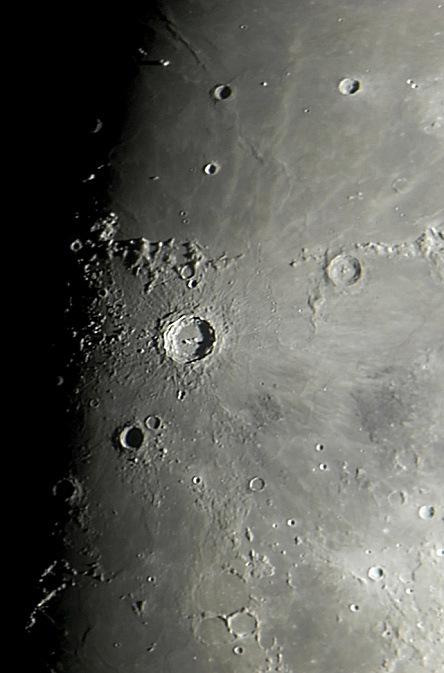
Tycho and the South Pole
Posted in Astrophotography with tags afocal, Casio Exilim EX-Z80, Clavius, Dob, Meade Lightbridge 16", Moon, non-motorized, Paint Shop Pro, Registax, shift-and-add, South Pole, Telescope, terminator, Tycho on 2009/04/04 by computerphysicslabA sequence of shots to the Moon taken with the Dob Meade Lightbridge 16″ telescope has been integrated into one final image, thanks again to Registax and Paint Shop Pro. This mosaic of Tycho crater and the South Pole region is composed of 30 individual frames. The biggest crater in the terminator is Clavius. Inside it there a lot of small craters.
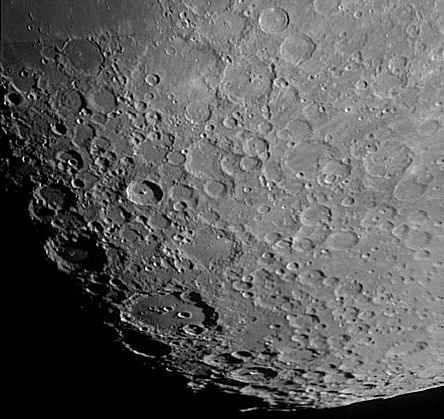
Silberschlag casts two shadows
Posted in Astrophotography with tags afocal, Astronomy, Binocular, Casio Exilim EX-Z80, Mare Tranquillitatis, Moon, shift-and-add, terminator, Vixen 12x80 on 2009/04/03 by computerphysicslabSilberschlag is a small Moon crater near Mare Tranquillitatis. What is my surprise when I observe that this crater shadow is proper of two peaks instead of a crater rim. Watch the picture and think about it. Is that normal?
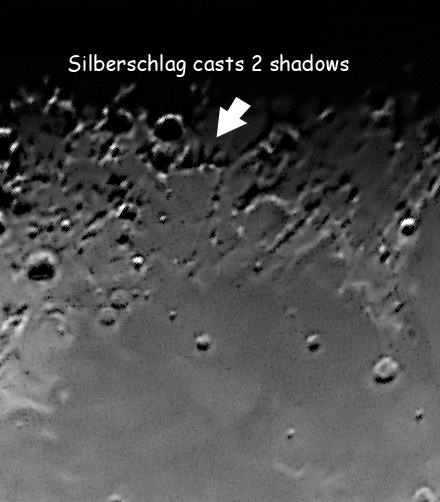
55 frames stacked in Registax
Posted in Astrophotography with tags afocal, Binocular, Casio Exilim EX-Z80, Moon, Registax, Vixen 12x80 on 2009/04/02 by computerphysicslabAfter stacking 55 frames of yesterday’s Crescent Moon, forcing a bit the saturation, and sharpening using the finest wavelet available, I am proud to introduce this Moon picture:
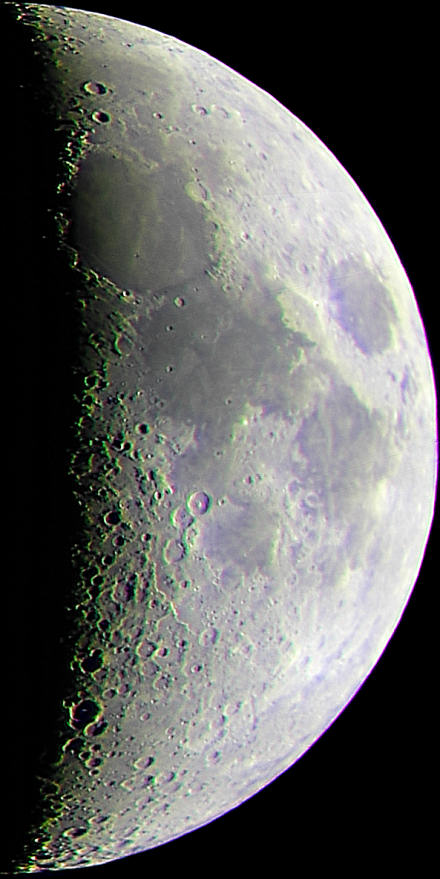
Foggy Crescent Moon
Posted in Astrophotography with tags afocal, Binocular, Casio Exilim EX-Z80, Crescent, Moon, Vixen 12x80 on 2009/03/31 by computerphysicslabYesterday’s moon was a bit foggy in my location. Nevertheless I got an image that I am very proud of, because it is the first time I obtain a nearly perfect focus thanks to the binocular focus tip. When doing afocal exposures, you may get a sharp focus using another binocular over the lens. This way you guarantee an infinite precise focus for the camera.
This image was taken as usual, through Vixen 12×80 binoculars and with the Casio Exilim EX-Z80 pocket digital camera. I used only green channel data, because it was the sharpest.

Humboldt crater
Posted in Astrophotography with tags Binocular, Casio Exilim EX-Z80, crater, edge-on, Full Moon, Humboldt, libration, limb, Moon, terminator, Vixen 12x80 on 2009/03/12 by computerphysicslabHumboldt crater as seen with the Vixen 12×80 binoculars. This is a big crater but very near to the Moon limb. One day after full moon, Humboldt delivers high contrast images due to its shadow. The day this shot was made, the Moon libration wasn’t the better one to view Humboldt in its extension, but edge-on. The inner central peaks are visible.

Gauss crater
Posted in Astrophotography with tags Berosus, Full Moon, Hahn, Mare Crisium, Moon on 2009/03/12 by computerphysicslabGauss is the big crater near Mare Crisium. It is visible one day after Full Moon, because this is the exact moment for its best shadow projection. Berosus and Hahn are the two smaller craters near Gauss. It is visible a tiny central peak inside Hahn crater. And inside Gauss we can barely spot a shadow that Gauss B casts. Gauss B is a small crater to be guessed in Gauss.

Almost Full Moon
Posted in Astrophotography with tags afocal, Binocular, Casio Exilim EX-Z80, Full Moon, Moon, Registax, Vixen 12x80 on 2009/03/10 by computerphysicslabHere we see a 13 days lunation Moon, almost full. Registax 5 did the work of stacking and wavelets. Focus was not perfect but wavelets fixed it. I multiplied the red channel to the green channel in order to enhance the image contrast.

Aristillus close-up
Posted in Astrophotography with tags Archimedes, Aristillus, Binocular, Casio Exilim EX-Z80, Cassini, craters, Mare Imbrium, Mons Piton, Montes Alpes, Montes Caucasus, Moon, Plato, Rükl, Vallis Alpes, Vixen 12x80 on 2009/03/04 by computerphysicslabAristillus, Cassini, Mons Piton, Montes Alpes and Vallis Alpes are visible in this close-up shot through the Vixen 12×80 binoculars. The area may be compared to that exposed in Rükl plate #12.
Archimedes and Plato are the biggest craters shown in this area, called Mare Imbrium. The biggest mountains below are Montes Caucasus. Some of its peaks (heights of 6 km) project big shadows.

The Moon highly saturated
Posted in Astrophotography with tags 114/1000, afocal, Astronomy, Casio Exilim EX-Z80, Catadioptric, color, Full Moon, Mare Tranquillitatis, Moon, Tanzutsu, Telescope, titanium on 2008/12/13 by computerphysicslabUsually we see the Moon as in a gray scale picture, with no color details. Nevertheless the Moon has different hues depending on the chemical composition of the terrain. For example, Mare Tranquillitatis has a blue tone due to its titanium high density. Processing a Moon picture computationally, we may exaggerate its colors, giving high saturation to RGB colors. In the resulting image, Mare Tranquillitatis is the most blueish dark area. Equipment: Telescope Tanzutsu Catadioptric 114/1000.

Moon & Exilim
Posted in Astrophotography with tags Astronomy, Casio Exilim EX-Z80, mare, Mare Crisium, Mare Tranquillitatis, Moon, shift-and-add, zoom on 2008/12/12 by computerphysicslabCasio Exilim EX-Z80 is a pocket digital camera, very useful to make photos during holidays or a trip. But it may also be used to do some kind of astrophotography. Its maximum zoom is 3x magnification. Here we see a comparison of a Moon shot with 1x and 3x zoom. With 1x zoom some big maria are visible, like Tranquillitatis, and at 3x even mare Crisium is captured.


